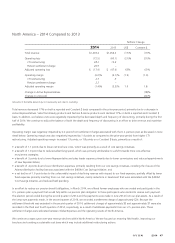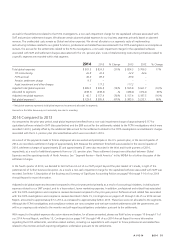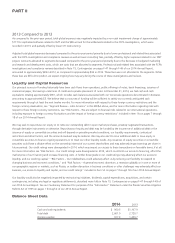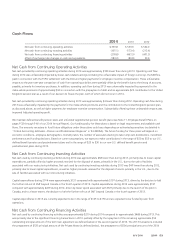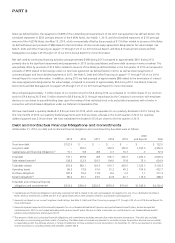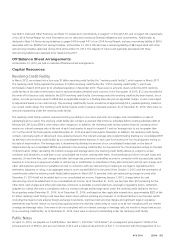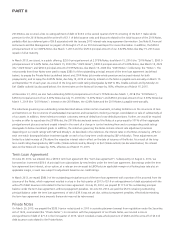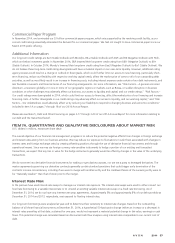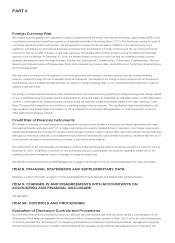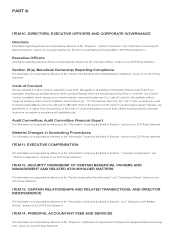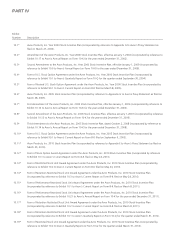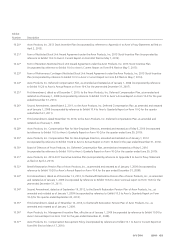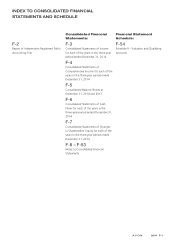Avon 2014 Annual Report Download - page 65
Download and view the complete annual report
Please find page 65 of the 2014 Avon annual report below. You can navigate through the pages in the report by either clicking on the pages listed below, or by using the keyword search tool below to find specific information within the annual report.Commercial Paper Program
In November 2014, we terminated our $1 billion commercial paper program, which was supported by the revolving credit facility, as our
current credit ratings essentially eliminated the demand for our commercial paper. We had not sought to issue commercial paper since our
March 2013 public offering.
Additional Information
Our long-term credit ratings are Ba1 (Stable Outlook) with Moody’s, BB+ (Stable Outlook) with S&P, and BB (Negative Outlook) with Fitch,
which are below investment grade. In November 2014, S&P lowered their long-term credit rating from BBB- (Negative Outlook) to BB+
(Stable Outlook). In October 2014, Moody’s lowered their long-term credit rating from Baa3 (Negative Outlook) to Ba1 (Stable Outlook). We
do not believe these long-term credit rating downgrades will have a material impact on our near-term liquidity. However, additional rating
agency reviews could result in a change in outlook or downgrade, which could further limit our access to new financing, particularly short-
term financing, reduce our flexibility with respect to working capital needs, affect the market price of some or all of our outstanding debt
securities, as well as most likely result in an increase in financing costs, including interest expense under certain of our debt instruments, and
less favorable covenants and financial terms of our financing arrangements. For more information, see “Risk Factors – A general economic
downturn, a recession globally or in one or more of our geographic regions or markets, such as Russia, or sudden disruption in business
conditions or other challenges may adversely affect our business, our access to liquidity and capital, and our credit ratings,” “Risk Factors –
Our credit ratings were downgraded in 2014, which could limit our access to financing, affect the market price of our financing and increase
financing costs. A further downgrade in our credit ratings may adversely affect our access to liquidity, and our working capital,” and “Risk
Factors – Our indebtedness could adversely affect us by reducing our flexibility to respond to changing business and economic conditions”
included in Item 1A on pages 7 through 18 of our 2014 Annual Report.
Please also see Note 5, Debt and Other Financing on pages F-17 through F-20 of our 2014 Annual Report for more information relating to
our debt and the maturities thereof.
ITEM 7A. QUANTITATIVE AND QUALITATIVE DISCLOSURES ABOUT MARKET RISK
(U.S. dollars in millions, except per share data)
The overall objective of our financial risk management program is to reduce the potential negative effects from changes in foreign exchange
and interest rates arising from our business activities. We may reduce our exposure to fluctuations in cash flows associated with changes in
interest rates and foreign exchange rates by creating offsetting positions through the use of derivative financial instruments and through
operational means. Since we may use foreign currency rate-sensitive instruments to hedge a portion of our existing and forecasted
transactions, we expect that any loss in value for the hedge instruments generally would be offset by changes in the value of the underlying
transactions.
We do not enter into derivative financial instruments for trading or speculative purposes, nor are we a party to leveraged derivatives. The
master agreements governing our derivative contracts generally contain standard provisions that could trigger early termination of the
contracts in some circumstances, including if we were to merge with another entity and the creditworthiness of the surviving entity were to
be “materially weaker” than that of Avon prior to the merger.
Interest Rate Risk
In the past we have used interest-rate swaps to manage our interest rate exposure. The interest-rate swaps were used to either convert our
fixed rate borrowing to a variable interest rate or to unwind an existing variable interest-rate swap on a fixed rate borrowing. As of
December 31, 2014, we do not have any interest-rate swap agreements. Approximately 5% and approximately 8% of our debt portfolio at
December 31, 2014 and 2013, respectively, was exposed to floating interest rates.
Our long-term borrowings were analyzed at year-end to determine their sensitivity to interest rate changes. Based on the outstanding
balance of all these financial instruments at December 31, 2014, a hypothetical 50-basis-point change (either an increase or a decrease) in
interest rates prevailing at that date, sustained for one year, would not represent a material potential change in fair value, earnings or cash
flows. This potential change was calculated based on discounted cash flow analyses using interest rates comparable to our current cost of
debt.
A V O N 2014 57


